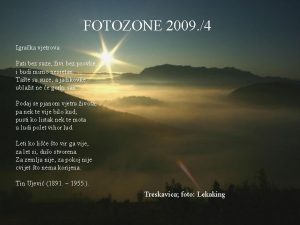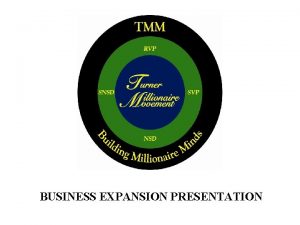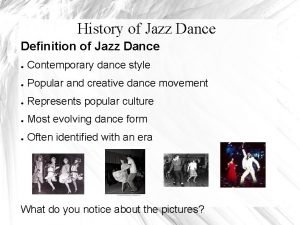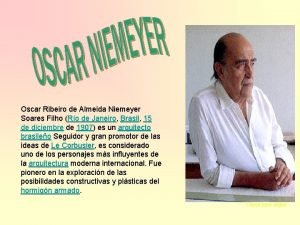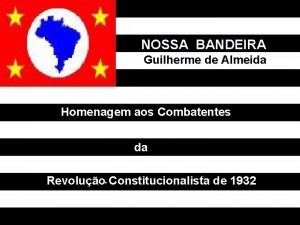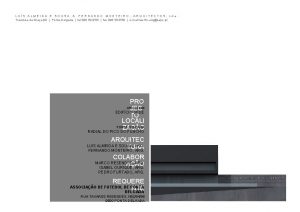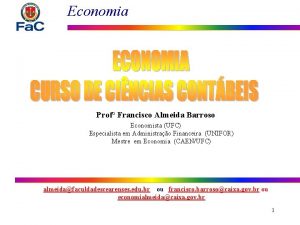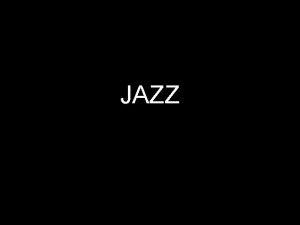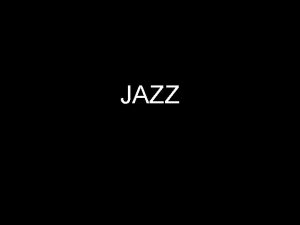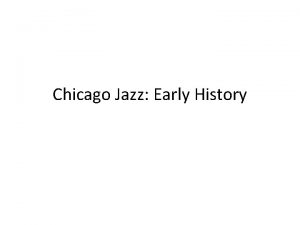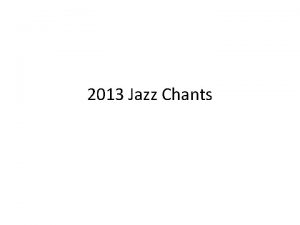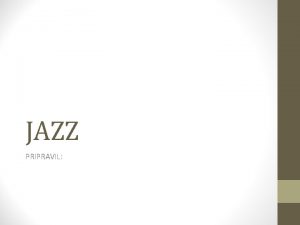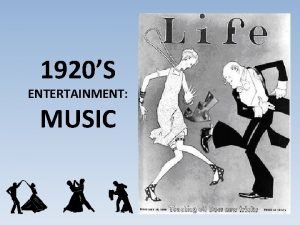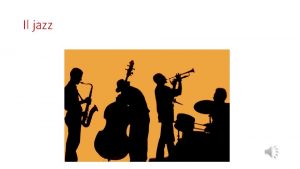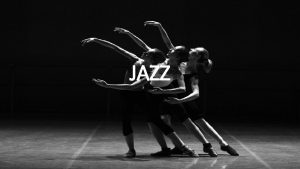JAZZ HISTORY PRESENTATION SUZE SEMEDO DE ALMEIDA WHERE













- Slides: 13

JAZZ HISTORY PRESENTATION SUZE SEMEDO DE ALMEIDA

WHERE DID JAZZ COME FROM? Jazz came from all over the world but it had its main influences. Jazz is a music genre originated in the African-American community in New Orleans in the United States. Jazz is a combination of influences of music merging to create jazz such as Afro Roots, Work Song, Military Band, Gospel Music, Blues and Alain Ragtime and Roaring 20’s. It originated in 1912 and has been a really famous genre till this day.

AFRO ROOTS • Afro Roots are a form of communication and it plays a functional role in African society. Slaves used work songs as a form of communication during slavery to communicate within each other in order so the masters wouldn’t be able to understand them, this was only because they weren’t allowed to speak their own language and were only allowed to speak English, so music became a mean of survival for the slaves. • From African music, jazz got its: rhythm and "feel“ "blues" quality tradition of playing an instrument in your own expressive way, making it an "extension" of your own human voice. https: //www. youtube. com/watch? v=jdwf. P 6 CMHn. M https: //www. youtube. com/watch? v=m. K 8 s 3 -1 A 1 Oc

GOSPEL MUSIC • Gospel music is rooted from Afro-Americans and it’s mostly used in religious music and any religious place. • Gospel music is a genre of Christian music. It is performed in cultural places such as churches and cultural events. • Gospel music goes all the way back to the early 17 th century with the roots of black oral tradition. https: //www. youtube. com/watch? v=5 njh 9 Dkcvwc

MILITARY WORK SONGS • Military music which its origin is from the European Army Tradition, they used musical instruments and those instruments played many important roles in the military culture for thousands of years. • In the army a military cadence is a traditional call and response work song sung by the army leaders and troops while running or marching , this is done by the leader singing something and the troops having to repeat the same thing after In unison although it’s not always the troops shouting the exact same thing as the leader. For this no instruments are needed since it’s done by the troops marching and their vocal abilities. This also helps them sent a rhythm and pace to their work. https: //youtu. be/4 Mw. Qcm 4 e. H 18

SLAVERY • Slavery was a system where someone was allowed to own, sell or buy another person and it was all legal to do so. • Jazz came alive after slavery and this also influenced the genre of jazz. Slavery started in 1619 when a Dutch ship brought 20 African slaves into the British Colony of Jamestown, Virginia, USA. The crew had seized the Africans from the Portuguese ship São João Bautista (mostly known as San Juan Batista). This was all throughout the 17 th century. 6 -7 million slaves were imported to the west- North and South America and Britain.

INFLUENCES ELLA JANE FITZGERALD • Ella Jane Fitzgerald was an American jazz singer sometimes referred to as First Lady of Song, Queen of Jazz or Lady Ella. She was noted for her purity of tone, impeccable diction, phrasing, intonation and a horn like improvisational ability, particularly in her scat singing. She was born on the 25 th April, 1917 and passed away on the 15 th June, 1996. • After a really bad adolescence, she found stability in the musical success with the Chick Webb Orchestra, performing across the country but most associated with Savoy Ballroom in Harlem. She first recorded with Chick Webb’s orchestra in 1935. After taking over the band Webb died, Fitzgerald left it behind in 1942 to start her solo career. Her manager was Moe Gale, co-founder of the Savoy, until she turned the rest of her career over to Norman Granz, who founded Verve Records to produce new records by Fitzgerald. With Verve she recorded some of her widely noted works, such as cry me a river. https: //youtu. be/2 Gn 9 A-kds. Ro

DIFFERENT DANCES • There are many different styles of dance within the jazz dance but three that I think are very important would be Cakewalk, Broadway Jazz and Charleston.

CAKEWALK • This particular style of dance is very significant compared to other forms of jazz dance. With all the dances that links to slavery, Cakewalk stands out. It was a socially acceptable way for slaves to make fun of their masters. The dances were usually held at the owner or master’s house and took the form of a competition. The winning dancers would receive cake as their prize. The dancers would line up and high step in a straight line as if to mock the wealthy people and masters they served under. • https: //youtu. be/Qifiy. Nm 6 j. G 4

CHARLESTON • Rising in popularity during the 1920 s, the Charleston remains to be a popular dance today. It involves pivoting the feet in and out, while straightening and bending the knees. The dancer will shift their weight from foot to foot, and as each foot is underweighted, it kicks out at an angle that is not at 90 degrees , it could be over or less than 90 degrees. • https: //youtu. be/p. Up. Ac. PAip. DA

BROADWAY JAZZ • Broadway jazz is performed on stage whereas broadway dance is performed in plays. • Jazz is a combination of ballet dance and dramatic acting in it, it has a lively rhythm and atmosphere to it. • This type of jazz is one of the most popular kinds for live audiences. The dances are often seen in Broadway musicals in New York theatres, and productions like Cabaret, Cats and All that Jazz musical. • https: //youtu. be/va 8 VDBGc. KS 4

TIME SIGNATURES • There are many different ways to time songs for music and dance routines. There are time signatures that helps us with the counts in music. • We have : • 4/4 which is a common time signature that a lot of tracks use , one bar equals to four counts. An example of it would be Yesterday by The Beatles. https: //youtu. be/Nrgmd. Oz 227 I • 3/4 this has three beats only and mostly used in waltz music , one bar equals to three counts. An example of it would bee Missouri Waltz by Dan and Harvey’s Jazz Band. https: //youtu. be/Mpa. OMzff. D 8 Y • 2/4 this has only two beats in it , one bar equals to 2 counts so it’s more slower. An example would be Weeding Songs and also Pachelbel’s Canon. https: //youtu. be/r. Nsg. HMkl. BW 0 • 5/4 this time signature is a more fast paced signature, it has five beats , one bar equals to five counts. The music feels as tho it’s split into different sections because the counts are over 4. An example of this would be Jazz Music and also Take Five by Dave Brubeck. https: //youtu. be/vm. DDOFXSg. As • 6/8 this time signature has six beats to it and one bar equals to six counts. Music can be split into two with three counts in each and it sounds very fast paced. An example of it would be The House of Rising Sun by The Animals. https: //youtu. be/0 Fy 7 op. Ku 46 c • 7/8 this has sevens beats to it, one bar equals to seven counts. It can be split into three different sections. An example of it would be Money by Pink Floyd. https: //youtu. be/cpbbua. IA 3 Ds

THE END • THANK YOU FOR WATCHING • HOPE YOU HAD FUN ; )
 Pati bez suze
Pati bez suze Suze orman primerica
Suze orman primerica Jazz dance origin
Jazz dance origin Definition of jazz dance
Definition of jazz dance Oscar ribeiro de almeida niemeyer
Oscar ribeiro de almeida niemeyer Marco antonio garcia de almeida
Marco antonio garcia de almeida Dr teddy de almeida
Dr teddy de almeida Karoline almeida rangel
Karoline almeida rangel Dra denise hematologista
Dra denise hematologista Bíblia almeida revista e atualizada ppt
Bíblia almeida revista e atualizada ppt Supondo que os desenhos abaixo fossem as representações
Supondo que os desenhos abaixo fossem as representações Nossa bandeira guilherme de almeida
Nossa bandeira guilherme de almeida Fernando monteiro
Fernando monteiro Thiago almeida barroso
Thiago almeida barroso
